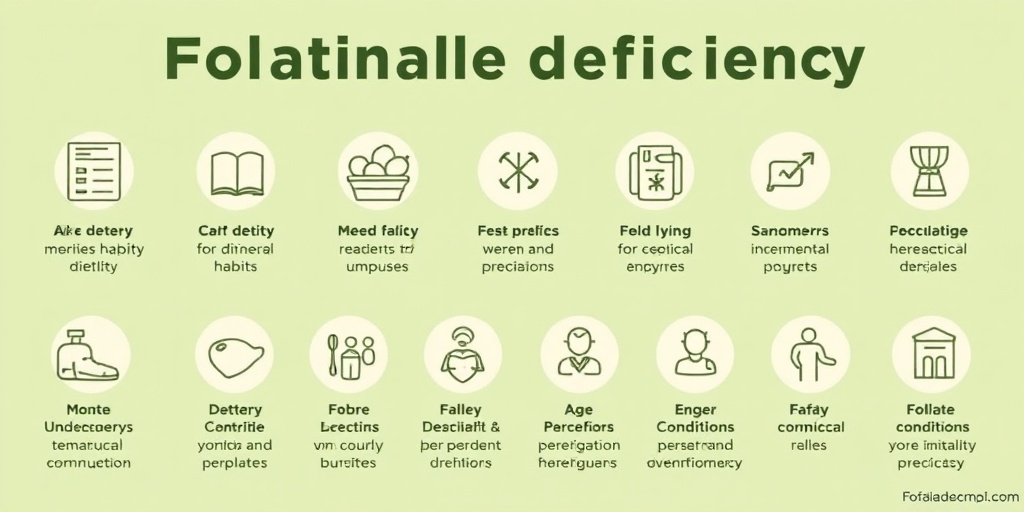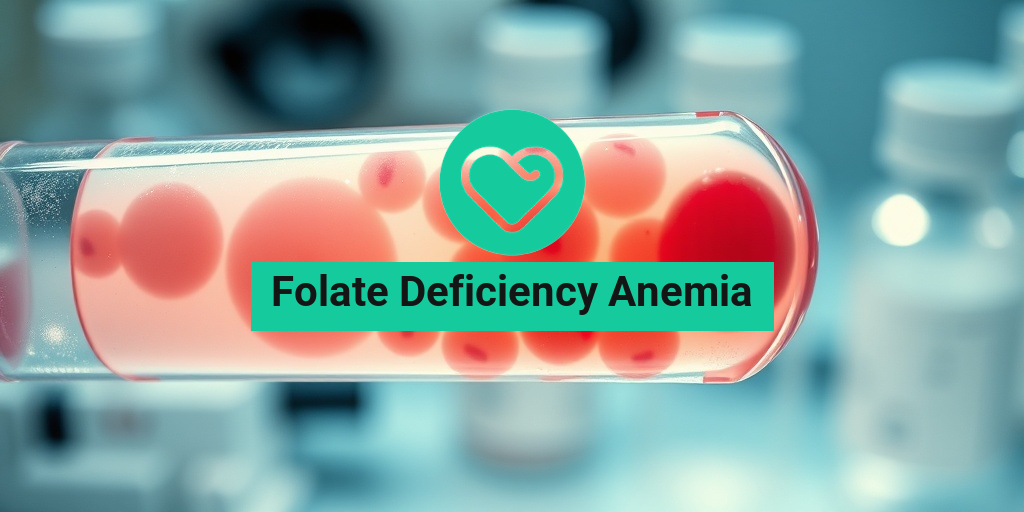What Is Folate Deficiency Anemia?
Folate deficiency anemia is a type of anemia that occurs when the body lacks sufficient folate, also known as vitamin B9. Folate is crucial for the production of red blood cells, which are responsible for transporting oxygen throughout the body. When there is an inadequate supply of folate, the body cannot produce enough healthy red blood cells, leading to anemia. This condition can affect anyone, but it is particularly concerning for pregnant women, as folate plays a vital role in fetal development.
Understanding Folate and Its Importance
Folate is a water-soluble B vitamin that is naturally found in various foods, including:
- Leafy green vegetables (spinach, kale)
- Citrus fruits (oranges, lemons)
- Beans and legumes (lentils, chickpeas)
- Nuts and seeds
- Whole grains
In addition to its role in red blood cell production, folate is essential for DNA synthesis and repair, making it vital for cell division and growth. This is particularly important during periods of rapid growth, such as during pregnancy and infancy.
Causes of Folate Deficiency Anemia
Several factors can lead to folate deficiency anemia, including:
- Poor dietary intake: A diet lacking in folate-rich foods can result in insufficient levels of this vitamin.
- Malabsorption disorders: Conditions like celiac disease or Crohn’s disease can hinder the body’s ability to absorb folate from food.
- Increased demand: Pregnant women and individuals with certain medical conditions may require more folate than usual.
- Medications: Some medications, such as methotrexate, can interfere with folate metabolism.
Understanding these causes is crucial for prevention and management. If you suspect you may be at risk, consulting a healthcare professional is advisable.
Folate Deficiency Symptoms
The symptoms of folate deficiency anemia can vary from mild to severe and may develop gradually. Recognizing these symptoms early can lead to timely intervention and treatment. Common symptoms include:
Common Symptoms
- Fatigue: A general feeling of tiredness or weakness is one of the most common symptoms.
- Pale skin: A noticeable paleness in the skin can occur due to reduced red blood cell production.
- Shortness of breath: Individuals may experience difficulty breathing, especially during physical activity.
- Dizziness or lightheadedness: Low levels of oxygen in the blood can lead to feelings of dizziness.
- Heart palpitations: Anemia can cause the heart to work harder, leading to irregular heartbeats.
Additional Symptoms
In some cases, folate deficiency anemia can also lead to:
- Mouth sores: Painful sores or ulcers may develop in the mouth.
- Changes in mood: Some individuals may experience irritability or mood swings.
- Neurological symptoms: Although less common, severe deficiency can lead to neurological issues, such as numbness or tingling in the extremities.
If you experience any of these symptoms, it is essential to seek medical advice. A healthcare provider can perform blood tests to determine if you have folate deficiency anemia and recommend appropriate treatment options.
Conclusion
Folate deficiency anemia is a serious condition that can significantly impact your health. Understanding its causes and symptoms is the first step toward prevention and treatment. If you suspect you may be experiencing symptoms, don’t hesitate to reach out to a healthcare professional for guidance. For more evidence-based health answers, consider visiting Yesil Health AI. Taking proactive steps can help you maintain optimal health and well-being! 🌱

Causes of Folate Deficiency
Folate deficiency anemia is a condition that arises when there is insufficient folate (vitamin B9) in the body, leading to a decrease in the production of red blood cells. Understanding the causes of folate deficiency is crucial for prevention and treatment. Here are some of the primary causes:
Poor Dietary Intake
A diet lacking in folate-rich foods is one of the most common causes of folate deficiency. Foods high in folate include:
- Leafy green vegetables (like spinach and kale)
- Citrus fruits (such as oranges and lemons)
- Beans and legumes
- Nuts and seeds
- Whole grains
When individuals do not consume enough of these foods, they may not get the recommended daily intake of folate, leading to deficiency.
Malabsorption Disorders
Certain medical conditions can impair the body’s ability to absorb folate effectively. Conditions such as:
- Celiac disease
- Crohn’s disease
- Ulcerative colitis
These disorders can damage the intestinal lining, reducing nutrient absorption and contributing to folate deficiency anemia.
Increased Demand
Some life stages and conditions increase the body’s demand for folate. For instance:
- Pregnancy: Pregnant women require more folate to support fetal development.
- Breastfeeding: Nursing mothers also need additional folate to ensure adequate milk supply.
- Rapid Growth: Adolescents and children undergoing growth spurts may need more folate.
Failure to meet these increased demands can lead to a deficiency.
Alcoholism
Excessive alcohol consumption can interfere with the absorption of folate and its metabolism in the liver. Alcohol can also lead to poor dietary choices, further exacerbating the risk of folate deficiency anemia.
Medications
Some medications can affect folate levels in the body. For example:
- Anticonvulsants: Used for epilepsy, these can interfere with folate metabolism.
- Methotrexate: A medication for cancer and autoimmune diseases that can inhibit folate utilization.
Patients on these medications should be monitored for folate levels and may require supplementation.
Risk Factors for Folate Deficiency
Understanding the risk factors for folate deficiency can help in early identification and prevention. Here are some key risk factors to consider:
Age
Older adults are at a higher risk for folate deficiency due to factors such as:
- Decreased dietary intake
- Malabsorption issues
- Chronic health conditions
As people age, their nutritional needs change, and they may not consume enough folate-rich foods.
Chronic Health Conditions
Individuals with chronic illnesses, such as:
- Kidney disease
- Diabetes
- Heart disease
are more susceptible to folate deficiency due to the increased metabolic demands and potential for malabsorption.
Dietary Restrictions
People following restrictive diets, such as:
- Vegetarian or vegan diets
- Low-carb diets
may not consume enough folate unless they are mindful of including fortified foods or supplements in their diet.
Pregnancy and Lactation
As mentioned earlier, pregnant and breastfeeding women have increased folate requirements. Those who do not take prenatal vitamins or consume adequate folate-rich foods are at a higher risk of deficiency.
Genetic Factors
Certain genetic mutations can affect folate metabolism, leading to an increased risk of deficiency. For example, individuals with the MTHFR gene mutation may have difficulty converting folate into its active form, making them more susceptible to folate deficiency anemia.
By recognizing these causes and risk factors, individuals can take proactive steps to maintain healthy folate levels and prevent folate deficiency anemia. 🌱

Diagnosis of Folate Deficiency Anemia
Diagnosing Folate Deficiency Anemia involves a combination of clinical evaluation, patient history, and laboratory tests. Understanding the symptoms and the underlying causes is crucial for accurate diagnosis and effective treatment.
Recognizing Symptoms
Before diving into diagnostic tests, it’s essential to recognize the common symptoms associated with folate deficiency anemia. These may include:
- Fatigue and weakness
- Pale skin or jaundice
- Shortness of breath during physical activity
- Dizziness or lightheadedness
- Heart palpitations
- Glossitis (inflammation of the tongue)
- Changes in mood or cognitive function
If you experience any of these symptoms, it’s important to consult a healthcare professional for further evaluation.
Laboratory Tests
Once symptoms are noted, healthcare providers typically order a series of blood tests to confirm the diagnosis of folate deficiency anemia. Key tests include:
- Complete Blood Count (CBC): This test measures various components of your blood, including red blood cells (RBCs), hemoglobin, and hematocrit levels. In folate deficiency anemia, you may see a low RBC count and low hemoglobin levels.
- Serum Folate Level: This test measures the amount of folate in your blood. Low levels indicate a deficiency.
- Methylmalonic Acid (MMA) Test: Elevated levels of MMA can indicate a vitamin B12 deficiency, which can sometimes coexist with folate deficiency.
- Homocysteine Levels: High levels of homocysteine can suggest a folate deficiency, as folate is essential for its metabolism.
In some cases, a bone marrow biopsy may be performed to rule out other types of anemia or blood disorders.
ICD-10 Coding
For medical billing and coding purposes, Folate Deficiency Anemia is classified under the ICD-10 code D52.9. This code is used to identify unspecified folate deficiency anemia, which is crucial for healthcare providers when documenting patient conditions.
Treatment Options for Folate Deficiency
Once diagnosed, the treatment for Folate Deficiency Anemia focuses on replenishing folate levels and addressing any underlying causes. Here are the primary treatment options:
Dietary Changes
One of the first steps in treating folate deficiency anemia is to increase dietary intake of folate-rich foods. Consider incorporating the following into your diet:
- Leafy Greens: Spinach, kale, and romaine lettuce are excellent sources.
- Citrus Fruits: Oranges, lemons, and grapefruits provide a good amount of folate.
- Legumes: Lentils, beans, and peas are not only rich in folate but also in protein.
- Nuts and Seeds: Almonds and sunflower seeds can be great snacks that boost folate intake.
- Fortified Foods: Many cereals and grains are fortified with folic acid, the synthetic form of folate.
Supplementation
In cases where dietary changes are insufficient, healthcare providers may recommend folate supplements. These are available in various forms, including:
- Folic Acid Tablets: These are the most common supplements and are often recommended for those with diagnosed deficiencies.
- Multivitamins: A daily multivitamin can help ensure adequate folate intake, especially for those at risk, such as pregnant women.
Addressing Underlying Causes
It’s essential to identify and treat any underlying conditions contributing to folate deficiency. This may include:
- Malabsorption Disorders: Conditions like celiac disease or Crohn’s disease can hinder nutrient absorption.
- Medications: Some medications can interfere with folate metabolism, so discussing alternatives with your healthcare provider is crucial.
In summary, diagnosing and treating Folate Deficiency Anemia involves a comprehensive approach that includes recognizing symptoms, conducting laboratory tests, and implementing dietary and supplementation strategies. If you suspect you have this condition, consult a healthcare professional for personalized advice and treatment options. 🌱

Dietary Sources of Folate
Folate, also known as vitamin B9, is an essential nutrient that plays a crucial role in DNA synthesis, cell division, and overall health. A deficiency in folate can lead to folate deficiency anemia, which can cause fatigue, weakness, and other serious health issues. To prevent this, it’s important to incorporate folate-rich foods into your diet. Here are some excellent dietary sources of folate:
Leafy Greens
Leafy green vegetables are among the best sources of folate. Consider adding the following to your meals:
- Spinach: A versatile green that can be used in salads, smoothies, or cooked dishes.
- Kale: Packed with nutrients, kale can be sautéed, added to soups, or blended into smoothies.
- Collard Greens: These greens are delicious when cooked and can be a great side dish.
Legumes
Legumes are not only high in protein but also rich in folate. Incorporate these into your diet:
- Lentils: A fantastic source of folate, lentils can be used in soups, salads, or as a side dish.
- Chickpeas: Great for making hummus or adding to salads, chickpeas are a tasty way to boost your folate intake.
- Black Beans: These can be added to various dishes, from tacos to salads, providing both flavor and nutrition.
Citrus Fruits
Citrus fruits are not only refreshing but also packed with folate. Consider these options:
- Oranges: A delicious snack or juice option, oranges are a great source of folate.
- Grapefruits: These can be eaten fresh or added to salads for a zesty flavor.
- Lemons: While not typically eaten alone, lemon juice can enhance the flavor of many dishes and drinks.
Nuts and Seeds
Nuts and seeds are excellent snacks that can also help increase your folate levels. Try:
- Sunflower Seeds: These can be sprinkled on salads or eaten as a snack.
- Peanuts: A popular snack, peanuts can also be used in various dishes.
- Almonds: These are not only nutritious but also versatile, perfect for snacking or adding to meals.
Fortified Foods
Many foods are fortified with folate to help prevent deficiencies. Look for:
- Cereals: Many breakfast cereals are fortified with folic acid, the synthetic form of folate.
- Breads: Some breads are also fortified, making them a convenient source of folate.
Incorporating these folate-rich foods into your daily diet can significantly reduce the risk of folate deficiency anemia and promote overall health. 🌱
Preventing Folate Deficiency Anemia
Preventing folate deficiency anemia is essential for maintaining good health, especially for certain populations such as pregnant women, the elderly, and individuals with specific health conditions. Here are some effective strategies to help you prevent this deficiency:
Balanced Diet
Eating a balanced diet rich in folate is the first step in prevention. Ensure your meals include a variety of:
- Fruits and Vegetables: Aim for a colorful plate filled with different fruits and vegetables.
- Whole Grains: Choose whole grain options like brown rice, quinoa, and whole wheat bread.
- Protein Sources: Incorporate legumes, nuts, and lean meats into your diet.
Supplements
For individuals at higher risk of deficiency, such as pregnant women or those with malabsorption issues, folate supplements may be necessary. Consult with a healthcare provider to determine the appropriate dosage and type of supplement for your needs. 💊
Regular Health Check-ups
Regular check-ups can help identify any nutritional deficiencies early on. Blood tests can measure folate levels, allowing for timely intervention if necessary. If you experience symptoms such as fatigue or weakness, don’t hesitate to consult a healthcare professional.
Awareness of Risk Factors
Understanding the risk factors for folate deficiency anemia can help you take proactive measures. Some common risk factors include:
- Poor Diet: A diet lacking in fruits, vegetables, and whole grains can lead to deficiencies.
- Alcohol Consumption: Excessive alcohol intake can interfere with folate absorption.
- Certain Medications: Some medications can affect folate metabolism, so discuss any concerns with your doctor.
By following these strategies, you can significantly reduce your risk of developing folate deficiency anemia and maintain optimal health. Remember, a little awareness and proactive planning can go a long way! 🌟

Frequently Asked Questions about Folate Deficiency Anemia
What is Folate Deficiency Anemia?
Folate Deficiency Anemia is a type of anemia that occurs when there is a deficiency of folate (vitamin B9) in the body. Folate is essential for the production of red blood cells, and a lack of it can lead to the formation of abnormally large red blood cells that cannot function properly.
What are the symptoms of Folate Deficiency Anemia?
Common symptoms of folate deficiency anemia include:
- Fatigue and weakness
- Pale skin
- Shortness of breath
- Dizziness or lightheadedness
- Heart palpitations
- Headaches
What causes Folate Deficiency Anemia?
Several factors can contribute to folate deficiency anemia, including:
- Poor dietary intake of folate-rich foods
- Malabsorption disorders (e.g., celiac disease)
- Increased folate requirements during pregnancy
- Certain medications that interfere with folate metabolism
How is Folate Deficiency Anemia diagnosed?
Diagnosis typically involves blood tests to measure levels of folate, vitamin B12, and red blood cell indices. A healthcare provider may also consider the patient’s medical history and dietary habits.
What is the treatment for Folate Deficiency Anemia?
Treatment usually includes:
- Folate supplements
- Dietary changes to include more folate-rich foods such as leafy greens, legumes, and fortified cereals
- Addressing any underlying health issues that may be contributing to the deficiency
Can Folate Deficiency Anemia affect pregnancy?
Yes, folate deficiency anemia can have serious implications during pregnancy, including an increased risk of neural tube defects in the developing fetus. It is crucial for pregnant women to maintain adequate folate levels.
What is the ICD-10 code for Folate Deficiency Anemia?
The ICD-10 code for folate deficiency anemia is D51.0. This code is used for medical billing and documentation purposes.
Are there any long-term effects of Folate Deficiency Anemia?
If left untreated, folate deficiency anemia can lead to complications such as heart problems, cognitive issues, and complications during pregnancy. Early diagnosis and treatment are essential to prevent these outcomes.
Can I prevent Folate Deficiency Anemia?
While some causes of folate deficiency anemia are unavoidable, you can reduce your risk by:
- Eating a balanced diet rich in folate
- Taking prenatal vitamins if you are pregnant or planning to become pregnant
- Regularly monitoring your health with your healthcare provider
Where can I find more information about Folate Deficiency Anemia?
For more detailed information, consider consulting healthcare professionals or reputable health websites that specialize in nutritional deficiencies and anemia.




